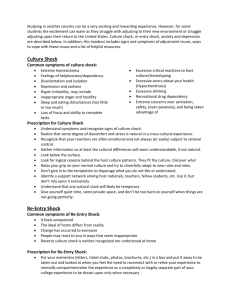11- Circulatory shock, fetal and pulmonary circulation
advertisement
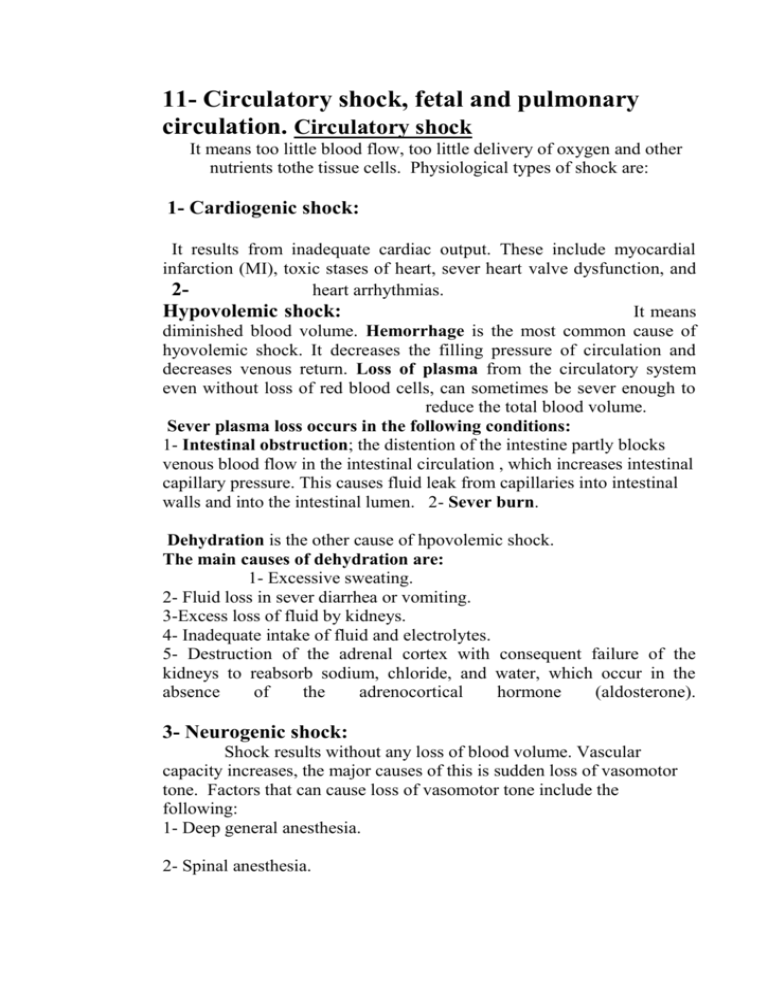
11- Circulatory shock, fetal and pulmonary circulation. Circulatory shock It means too little blood flow, too little delivery of oxygen and other nutrients tothe tissue cells. Physiological types of shock are: 1- Cardiogenic shock: It results from inadequate cardiac output. These include myocardial infarction (MI), toxic stases of heart, sever heart valve dysfunction, and 2heart arrhythmias. Hypovolemic shock: It means diminished blood volume. Hemorrhage is the most common cause of hyovolemic shock. It decreases the filling pressure of circulation and decreases venous return. Loss of plasma from the circulatory system even without loss of red blood cells, can sometimes be sever enough to reduce the total blood volume. Sever plasma loss occurs in the following conditions: 1- Intestinal obstruction; the distention of the intestine partly blocks venous blood flow in the intestinal circulation , which increases intestinal capillary pressure. This causes fluid leak from capillaries into intestinal walls and into the intestinal lumen. 2- Sever burn. Dehydration is the other cause of hpovolemic shock. The main causes of dehydration are: 1- Excessive sweating. 2- Fluid loss in sever diarrhea or vomiting. 3-Excess loss of fluid by kidneys. 4- Inadequate intake of fluid and electrolytes. 5- Destruction of the adrenal cortex with consequent failure of the kidneys to reabsorb sodium, chloride, and water, which occur in the absence of the adrenocortical hormone (aldosterone). 3- Neurogenic shock: Shock results without any loss of blood volume. Vascular capacity increases, the major causes of this is sudden loss of vasomotor tone. Factors that can cause loss of vasomotor tone include the following: 1- Deep general anesthesia. 2- Spinal anesthesia. 3- Brain damage. 4- Anaphylactic and histamine shock: It is an allergic condition. It results from an antigen-antibody reaction. Basophiles and mast cells release histamine or histamine-like substance. Histamine increased capillary permeability with rapid loss of fluid and protein into tissue space. Also Intravenous injection of large amount of histamine causes histamine shock. 5- Septic shock: It means bacterial infection (blood poisoning). It is important to the clinician because this type of shock is more frequency than other kind of shock. It causes death in the modern hospital. Causes of septic shock 1- Peritonitis caused by spread of are: infection from uterus and fallopian tubes. 2-Peritonitis resulting 3from rupture of the gut. Generalized infection from skin. 4Generalized infection from gas gangrene bacilli. 5- Infection from the kidney or urinary tract caused by colon ` bacilli. The features of septic shock are high fever, vasodilatation, high cardiac output, and development of micro blood Trauma to the body clots. causes either hemorrhage or damage the capillaries sufficient to allow excessive loss of plasma into tissue. Also trauma causes neurogenic shock by pain. Compensated shock (non progressive shock): The sympathetic reflexes prevent further deterioration of the circulation, and attempt to return arterial pressure back to normal level. The sympathetic reflexes provide immediate recovery within 30 seconds after hemorrhage.. Other factors include the 1-Central following: nervous system ischemic response. 2Formation of angiotensin by the kidneys. 3- Formation of vasopressin (antidiuretic hormone). 4- Other compensatory mechanisms such as absorption of large quantities of fluid from the intestine, from the interstitial spaces into blood capillaries, conservation of water and salt by the kidneys, and increased thirst and increased appetite for salt. Irreversible shock (progressive shock): Hemorrhage beyond certain critical level causes shock to become progressive. Many destructive enzymes have been released into the body fluid from damaged tissue , much acidosis has developed, high energy phosphates in tissues of the body are diminished in sever degrees of shock. Physiological treatment in shock: 1- Replacement therapy: If a person is in shock caused by hemorrhage, the best therapy is transfusion of whole blood. If the shock is caused by plasma loss, the best therapy is administration of plasma. When dehydration is the cause, administration of electrolyte solution can correct the shock. Whole blood is not always available, plasma can substitute. Sometimes plasma also is unavailable, dextran solution can substitute. 2- Sympathomimetic drugs: Smpathomimetic drug is a drug that mimics sympathetic stimulation. These drugs include norepiphrine, epinephrine, and a large number of long-acting drugs that have the same effect of them. They are beneficial in neurogenic and anaphylactic shock. They have not proved to be very valuable in hemorrhagic shock because the sympathetic nervous system has become maximally activated by circulatory reflexes. 3- Head-Down position: When the pressure falls too low especially in hemorrhagic and neurogenic shock, placing the patient with the head at least 12 inches lower than the feet helps in promoting venous return and increasing COP. 4- Oxygen therapy: It is less value because the problem is not inadequate oxygenation of blood in the lungs but inadequate transport of blood after it is 5Treatment with oxygenated. glucocorticoids: Glucocorticoids are frequently given to patients in sever shock for several reasons: 1- they increase the strength of the heart in late stages of shock; 2- they prevent release of lysosomal enzymes into the cytoplasm of the cells; and 3- they may aid in the metabolism of glucose by the severely damaged cells. Circulatory arrest: In which all blood flow stops. This occurs frequently on the surgical operating table as a result of cardiac arrest or ventricular fibrillation. Ventricular fibrillation can be stopped by strong electroshock of the heart. Cardiac arrest often results from little oxygen in the anesthetic gaseous mixture or from a depressant effect of the anesthesia itself. A normal cardiac rhythm can be restored by removing the anesthetic and immediately applying cardiopulmonary resuscitation procedures with supplying the patient's lungs with adequate quantities of oxygen. In general, more than 5 minutes of total circulatory arrest can cause at least some degree of permanent brain damage in more than one half of patients. Circulatory arrest for as long as 10 minutes permanently destroys mental power. Placental and fetal circulation Placental circulation: Placenta is maternal portion, is in effect a large blood sinus. Into this lake project the villi of the fetal portion containing the small branches of the fetal umbilical arteries and vein. The functions of placenta are: 1- The placenta is fetal lung where O2 and CO2 are exchanged, but the cellular covering the villi are thicker and less permeable than alveolar membrane in the lungs, exchange is much less efficient. 2- The placenta is also the rout by which all nutrient materials enter the fetus and by which fetal wastes are discharged to the maternal blood. Figure (47). Fetal circulation: The blood in the umbilical vein is about 80 % saturated with O 2 compared with 98 % saturation in the arterial circulation of the adult. The ductus venosus diverts some of blood directly to the inferior vena cava, and the remainder mixes with the portal blood of the fetus. The portal and systemic venous blood of fetus is only 26% saturated. The saturated of mixed blood in the inferior vena cava is approximately 67%. Most of blood entering the heart through the inferior vena cava is diverted directly to the left atrium via the patent foramen oval. Most of the blood from the superior vena cava enters the right ventricle and expelled into the pulmonary artery. The resistant of the collapsed lungs is high, and the pressure in the pulmonary artery is several mmHg higher than it is in the aorta, so that most of the blood in the pulmonary artery passes through the ductus arteriosus to the aorta. The relatively unsaturated blood from the right ventricle is diverted to the trunk and lower body of the fetus, while the head of the fetus receives the better oxygenated blood from the left ventricle. From the aorta, some of the blood is pumped into the umbilical arteries and back to the placenta. The O2 saturation of the blood in the lower aorta and umbilical arteries of the fetus is approximately 60%. About 55% of fetal cardiac output goes through placenta. Figure (48). Changes in fetal circulation at birth: 1-The placental circulation is cut off and the peripheral resistance suddenly rises. The pressure in the aorta rises until it exceeds that in the pulmonary artery. The ductus arteriosus constricts within a few hours after birth, producing functional closure, and permanent anatomical closure follows in the next 24-48 hrs. 2- The infant gasps several times and the lungs expand. Pulmonary blood flow increases markedly. Blood returning from the lungs raises the pressure in left atrium closing the foramen oval by pushing the valve against the inter-atrial septum. Closure of foramen oval prevents the leftto-right flow of arterial blood and improves the oxygenation of systemic arterial blood. 3- Closure of two umbilical arteries and umbilical vein. Figure (47): Placental circulation (Ganong's review of medical physiology 2010). Figure (48): Fetal circulation(Ganong's review of medical physiology 2010). . Pulmonary circulation Systolic pulmonary arterial pressure is 25 mmHg, and diastolic is 8 mmHg. The pulmonary vascular resistance is about 1/8 that of systemic circulation, and this why pulmonary arterial pressure is much lower than aortic pressure. The wall of pulmonary artery and its large branches are about 30% as thick as the wall of the aorta. The main velocity of the blood in the root of the pulmonary artery is the same as that in the aorta. Pulmonary veins are an important blood reservoir when a normal individual lies down the pulmonary blood volume increase by up to 400 ml and when the person stands up is discharged into the general circulation. This shift is the cause of decrease in vital capacity in the supine position and is responsible for the occurrence of orthopnea in heart failure. The blood flow through the lung: The blood distribution in lung is affected by many factors: 1- Alveolar oxygen concentration: When concentration of oxygen in alveoli decreases below normal (below 70 mmHg) the pulmonary capillaries will constrict. In pulmonary circulation hypoxia causes vasoconstriction which shunt blood away from poorly ventilated area toward well-ventilated area where gas exchange can occur. 2- Autonomic nervous control: Stimulation of vagus causes vasodilatation and sympathetic cause vasoconstriction. 3- Effect of hydrostatic pressure (effect of gravity): gravity has marked effect on the pulmonary circulation. In the upright position, the upper portions of the lungs are above the level of the heart, and the bases are at or below it. Consequently, in the upper part of the lungs, blood flow is less and ventilation is less than at base. So in normal adult, we can divide the lung into three zones: A- Zone I: No blood flow during any part of cardiac cycle. B- Zone II: Intermittent blood flow only when systolic pressure is greater than the alveolar pressure but diastolic pressure is less than alveolar pressure. C- Zone III: Continuous bloods flow because the alveolar capillary pressure remains greater than alveolar pressure during the entire cardiac cycle. 4- Effect of exercise: During exercise, increase in pulmonary blood flow. The whole lung is considered as zone III.

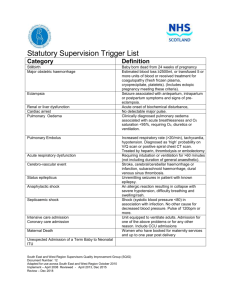

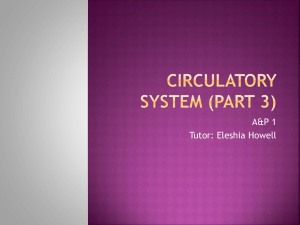
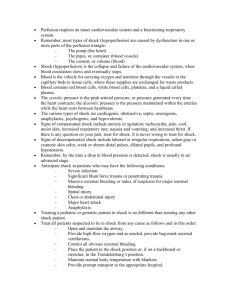
![Electrical Safety[]](http://s2.studylib.net/store/data/005402709_1-78da758a33a77d446a45dc5dd76faacd-300x300.png)

